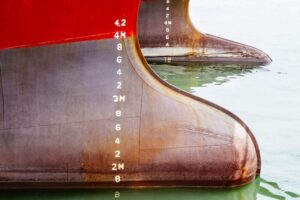By Subhodeep Ghosh
The draft or draught is nothing but the linear measure of the amount of sinkage or submergence of the vessel’s hull in the water. When we say that a vessel has a draft of 10 metres, it essentially means that the depth of the hull submerged in water is 10 metres, or the vertical distance or height from the bottom shell plating to the water level is the same as mentioned.

This quantity differs from the depth, which is the entire vertical height of the hull. The difference between the depth and the draft, essentially the linearly vertical measure of the hull above the water level, is known as the vessel’s freeboard.
The measure of the draft is vital in several ways; the main being a direct relationship with the significant physical parameter displacement, which is nothing but the equivalent weight of the vessel in the water or the volume of water displaced by the hull, which in mass-terms is equal to the buoyant force provided by the water to keep the vessel afloat under the given conditions.
Draft Lines
So, as the draft gives a linear measure of the submergence of the hull, it can be directly used as an estimate for displacement. Moreover, it helps the designer understand the extent of submergence of the ship’s hull when afloat. Hence, it also gives a clear picture of the clearance or the vertical distance above the waterline to the main deck level.
Thus, for a given hull depth, the higher the draft, the lesser the freeboard or the safe clearance before flooding the main or exposed deck. However, a high draft doesn’t necessarily mean something to be concerned about.
Most large sea-going cargo vessels have a high degree of the draft due to the cargo carried under fully loaded conditions or even ballasting after offloading cargo.
In other words, the draft is always high for large vessels due to the increased displacement it has to cater to from the first principles of flotation and buoyancy.
The high draft of these vessels offers several advantages in terms of hydrodynamics and stability characteristics. On the other hand, smaller ships in shallow water conditions like rivers or lakes have lower drafts.
Many think that in the early stages of vessel design, along with length and breadth. But though it is essential and always present in any vessel’s basic dimensions, the draft is more important!
When a client gives a requirement for the deadweight or tonnage capacity of a vessel, the designer has a picture of the feasible displacement (deadweight plus lightweight) and plays with the length, breadth, and draft to have the optimum design within the maximum limits of the displacement, adhering to the deadweight requirements, of course, and also maximising the spaces for cargo, accommodations, services, and other utilities.
Once the length, breadth, and draft are fixed in line with the required displacement, the depth is decided based on the type and size of the vessel and other factors like stability. So, in simple terms, the depth of the hull can be finalised only after the designer has confidence in the feasible draft of the vessel.
All vessels have a typical marking on the side of the hull, like a series of parallel branching lines and a circular disc. The numbers are known as draft marks or Plimsoll lines.
Kindly like us on Facebook/twitter















